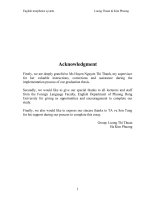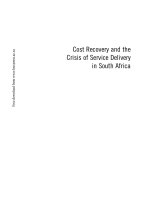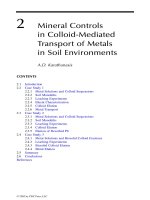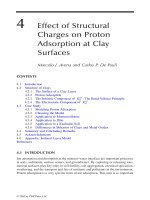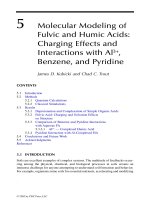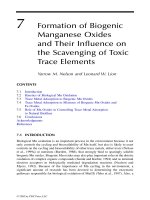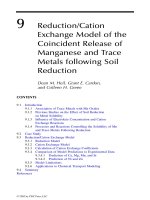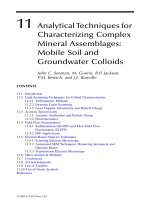Photophysical investigation and pharmaceutical applications of chlorin e6 in biodegradable carriers
Bạn đang xem bản rút gọn của tài liệu. Xem và tải ngay bản đầy đủ của tài liệu tại đây (3.98 MB, 231 trang )
PHOTOPHYSICAL INVESTIGATION AND
PHARMACEUTICAL APPLICATIONS OF CHLORIN e6
IN BIODEGRADABLE CARRIERS
SHUBHAJIT PAUL
NATIONAL UNIVERSITY OF SINGAPORE
2013
PHOTOPHYSICAL INVESTIGATION AND
PHARMACEUTICAL APPLICATIONS OF CHLORIN e6
IN BIODEGRADABLE CARRIERS
SHUBHAJIT PAUL
M.Pharm (Hons.), Jadavpur University
A THESIS SUBMITTED
FOR THE DEGREE OF DOCTOR OF PHILOSOPHY
DEPARTMENT OF PHARMACY
NATIONAL UNIVERSITY OF SINGAPORE
2013
DECLARATION
I hereby declare that the thesis is my original work and it has been written by me in its
entirety. I have duly acknowledged all the sources of information which have been used in
the thesis.
This thesis has also not been submitted for any degree in any university previously.
Shubhajit Paul
23 January, 2013
ACKNOWLEDGEMENT
I would like to express my heartfelt thanks to my supervisors, A/P Chan Lai Wah and A/P
Paul Heng Wan Sia for their patience, guidance, encouragements and opportunities in
mentoring me throughout my candidature. I am grateful to both of them for their critical
and valuable suggestions and ideas in framing this thesis. I would also like to thank Asst.
Prof. Celine Liew and Prof. Kurup for their suggestions to improve my work and for
being so cordial.
I would like to acknowledge the kindness of Asst. Prof. Gigi Chew, Asst. Prof.
Eng Hui and A/P Victor Yu to let me use the zetasizer, epifluorescence and confocal
microscope.
I’m highly indebted to National University of Singapore for providing the
research scholarship as well as the research opportunity to pursue Doctor of Philosophy. I
would also like to thank Teresa and Mei Yin for their kind support and being so
approachable.
I would also like to extend my heartfelt thanks to all other faculty members, lab
technicians, office staffs, and department friends for their cooperation and contribution
towards the completion of my project. My sincere appreciation goes to each of my
present friends and past colleagues in GEANUS, who always extended their hands when I
asked for help.
A very special thanks to all of my flatmates and friends in Singapore, who stood
beside me in every tortuous experience of my life and made these four years enjoyable
and memorable.
Finally, I want to express my deepest respect to my Late grandmother and Late
mother for their heartiest inspirations in the path to achieve a higher degree. I’m also
highly indebted to my cousin brother and my close friends for their unconditional support
to my family during my absence. I’m thankful to Susmita for her inspirations for
successful completion of my candidature. Above all, I thank The Supreme Being for
giving me the strength to endure the loss of my dearest grandmother and mother and the
determination to look forward in life.
I believe, the virtues and qualities I earned in this journey, will hone my strength
and determination for future endeavour.
Shubhajit
Jan, 2013
DEDICATION
Mom,
There is no feeling so comforting and solacing than knowing you
are right next to me for every endeavour I step in. They say you
are no more, but your lessons, inspirations and commitments
to make me a good human being will always be remembered.
i
TABLE OF CONTENTS
TABLE OF CONTENTS……………………………………………………………… i
SUMMARY………………………………………………………………………………v
LIST OF TABLES…………………………………………………………………… vii
LIST OF FIGURES…………………………………………………………………… ix
LIST OF SYMBOLS AND ABBREVIATIONS…………………………………… xv
1. INTRODUCTION 2
1.1. Background 2
1.2. Photosensitizers in the treatment of cancer 3
1.2.1. Different classes of photosensitizers 4
1.2.2. Mechanism of photosensitization 7
1.2.3. Chemical and photophysical properties of photosensitizers 8
1.2.4. Factors affecting photosensitization 9
1.2.5. Advantages and disadvantages of PDT 16
1.2.6. Challenges in PDT 18
1.2.7. Nanoparticles as delivery platform for PDT 19
1.2.8. Chlorins as promising photosensitizer 29
1.2.9. Research gaps in photophysical aspects and formulation strategies for Ce6 .30
2. HYPOTHESES AND OBJECTIVES 36
3. EXPERIMENTAL 42
3.A. Materials 42
3.B. Photophysical studies of Ce6 43
3.B.1. Aggregation study of Ce6 in aqueous media 43
3.B.1.1. Determination of Ce6 solubility at different pH 43
3.B.1.2. Determination of Ce6 partition coefficient at different pH 43
3.B.1.3. Determination of spectroscopic characteristics of Ce6 at different pH 44
3.B.1.4. Quantification of Ce6 species at different pH 45
3.B.1.5. Determination of relative quantum yield of Ce6 at different pH 45
3.B.2. Disaggregation study using PVP and sucrose esters 46
ii
3.B.2.1. Preparation of test solutions for disaggregation study 46
3.B.2.2. Measurement of absorption and fluorescence 46
3.B.2.3. Determination of disaggregation efficiency of PVP and sucrose esters 47
3.B.2.4. Measurement of fluorescence anisotropy 47
3.B.2.5. Determination of Ce6-disaggregating agent binding constant 48
3.B.2.6. Determination of Ce6-disaggregating agent binding mode 50
3.B.2.7. Theoretical simulation of Ce6-disaggregating agent system 51
3.C. Preparation of Ce6 formulation 55
3.C.1. Dissolution enhancement of Ce6 by formulating into sucrose ester-based
nanosuspension 55
3.C.1.1. Experimental design for the study of Ce6-sucrose ester nanosuspension
production 55
3.C.1.2. Preparation of Ce6-sucrose ester nanosuspension 57
3.C.2. Enhanced mucoadhesivity of nanoparticles by formulating Ce6-PVP complex in
alginate-based carriers 57
3.C.2.1. Experimental design for the study of alginate nanoparticles containing Ce6-
PVP complex 57
3.C.2.2. Method for preparing Ce6-PVP complex in alginate nanoparticles 58
3.D. Determination of various dependent variables of different Ce6 formulations 59
3.D.1. Particle size and zeta potential 59
3.D.2. Encapsulation efficiency 59
3.D.3. In vitro release of Ce6 61
3.D.4. In vitro mucoadhesivity of alginate nanoparticles consisting Ce6-PVP complex62
3.E. Response surface optimization and model validation 63
3.F. Characterization of optimized Ce6 nanoparticles of different formulations 64
3.F.1. Transmission electron microscopy 64
3.F.2. FT-IR spectroscopy 64
3.F.3. Differential Scanning Calorimetry 65
3.F.4. X-ray diffraction 65
3.G. Evaluation of in vitro PDT efficacy of Ce6 formulations 65
3.G.1. Singlet oxygen generation efficiency 66
3.G.2. Uptake of Ce6 nanoparticle formulations by OSC cells 67
iii
3.G.3. In vitro phototoxicity 68
3.G.4. Confocal laser scanning microscopy 68
3.H. Statistical analysis of data……………………………………… …………………… 68
4. RESULTS AND DISCUSSION 72
4.A.1. Elucidation of photophysical properties of aggregated Ce6 in aqueous media 72
4.A.1.1. Overview 72
4.A.1.2. Effect of pH on Ce6 solubility and partition coefficient 72
4.A.1.3. Effect of pH on absorption and fluorescence spectra of Ce6 74
4.A.1.4. Effect of pH on Ce6 quantum yield 79
4.A.1.5. Effect of Ce6 concentration on aggregate formation 80
4.A.1.6. Summary 83
4.A.2. Utilization of PVP for disaggregation of Ce6 aggregates 84
4.A.2.1. Overview 84
4.A.2.2. Effect of PVP on absorption and fluorescence spectra of Ce6 84
4.A.2.3. Effect of PVP on fluorescence anisotropy 90
4.A.2.4. Binding constant of Ce6-PVP complex 91
4.A.2.5. Binding mode of Ce6-PVP complex 94
4.A.2.6. Molecular dynamics simulation of Ce6-PVP complex 97
4.A.2.7. Summary 98
4.A.3. Utilization of sucrose esters for disaggregation of Ce6 aggregates 100
4.A.3.1. Overview 100
4.A.3.2. Absorption and fluorescence spectra of Ce6 in the presence of sucrose
esters…………………………………………………………………………… 100
4.A.3.3. Effect of different alkyl chains of sucrose ester on steady-state fluorescence
anisotropy of Ce6 105
4.A.3.4. Quantification of relative disaggregation efficiency of sucrose esters with
different alkyl chain using EEM spectroscopy 106
4.A.3.5. Binding constant of Ce6-sucrose ester complex 108
4.A.3.6. Determination of binding mode between Ce6 and sucrose esters 109
4.A.3.7. Simulation of disaggregation effect of sucrose esters on Ce6 aggregates
using DPD model 111
4.A.3.8. Summary 118
iv
4.A.4. PDT efficacy of various Ce6-disaggregating agent formulations 119
4.A.4.1. Overview 119
4.A.4.2. In vitro singlet oxygen generation 119
4.A.4.3. Intracellular uptake of Ce6 from various formulations 121
4.A.4.4. Anti-proliferative activity of Ce6-disaggregating agent formulations 124
4.A.4.5. Summary 126
4.B.1. Dissolution enhancement of Ce6 by formulating into sucrose ester-based
nanosuspension 128
4.B.1.1. Overview 128
4.B.1.2. Preparation of Ce6-sucrose ester nanosuspension 128
4.B.1.3. Evaluation of central composite design results 131
4.B.1.4. Characterization of SEP/SEL-Ce6 NS 141
4.B.1.5. PDT efficacy of SEP/SEL-Ce6 NS 146
4.B.2. Improved mucoadhesivity of alginate nanoparticles containing Ce6-PVP
complex 154
4.B.2.1. Overview 154
4.B.2.2. Preparation of alginate nanoparticles containing Ce6-PVP complex…… 152
4.B.2.3. Evaluation of 3
2
factorial design results 156
4.B.2.4. Characterization of Ce6-PVP-Alg nanoparticles 165
4.B.2.5. PDT efficacy of Ce6-PVP loaded alginate nanoparticles 170
4.B.2.6. Summary 175
5. CONCLUSION 178
6. LIST OF REFERENCES 182
v
SUMMARY
Photodynamic therapy is an emerging treatment modality for cancer as it is a non-
invasive, inexpensive and able to produce targeted effect. It is based on the dynamic
interaction of light, oxygen and a fluorescence molecule (photosensitizer) to induce
oxidative damage in cancerous cells. Chlorin e6 (Ce6), introduced in the early 90‟s has
widely been used as photosensitizer of interest. However, the photodynamic efficacy of
Ce6 is largely limited by its tendency to form aggregates. In addition, strong
hydrophobicity of Ce6 adversely affects its bioavailability.
In this study, it was hypothesized that aggregation of Ce6 could be prevented by using
suitable pharmaceutical adjuvants, which would render Ce6 aggregates into its
monomeric form. Furthermore, it was anticipated that these adjuvants could also be used
as drug carrier for Ce6 if appropriately formulated. Their dual characteristics would
therefore satisfy the necessity of a disaggregating agent and a drug carrier together.
The study was divided into two parts, comprising photophysical investigation and
pharmaceutical applications. In the first part, the influence of physicochemical factors
such as pH and Ce6 concentration on the aggregate formation were extensively studied.
The findings suggested that Ce6 preferentially exist as aggregates in the acidic to near
neutral pH conditions as exhibited by broadened absorption spectra, reduced fluorescence
intensity and lower quantum yield in the afore-mentioned pH conditions. In these pH
conditions, Ce6 had a higher octanol/water partition coefficient value with lower aqueous
solubility, suggesting aggregation was promoted by hydrophobic force. Novel
chemometric quantification was applied employing Parallel Factor (PARAFAC)
vi
algorithm to determine the fraction of different species of Ce6 (aggregate or monomer) at
varying pH conditions. The results obtained were in good agreement with the
spectroscopic findings, confirming significant influence of pH on Ce6 aggregation and
photophysical properties.
The disaggregation potential of polyvinylpyrrolidone (PVP) and sucrose esters (SE) was
investigated. Disaggregation efficiency of PVP and SE gradually increased on decreasing
the PVP molecular weight and increasing the alkyl chain of SE respectively. Using
thermodynamic studies, the disaggregation effect was found to be mediated by
hydrophobic interactions. Simulations at molecular level showed that Ce6 monomers
could be entangled at different locations of the PVP macromolecules or incorporated into
the hydrophobic core of SE.
In the second part, selected formulations were evaluated. A modified hot-melt
emulsification method was used to prepare Ce6-SE nanosuspension, where Ce6 was
encapsulated as amorphous form in the SE matrix resulting in enhanced in vitro
dissolution. Encapsulating Ce6-PVP complex in alginate nanoparticles further enhanced
the mucoadhesivity of the formulation. These formulations were optimized using
appropriate statistical designs. The photodynamic efficacy of these formulations was
evaluated using extent of singlet oxygen generation, cellular uptake and phototoxicity to
oral squamous carcinoma cells as determining parameters. The optimized formulations
were found to exhibit superior photodynamic activity against oral squamous carcinoma
cells in comparison with aggregate-rich solution form of Ce6.
vii
LIST OF TABLES
Table 1: List of various irradiation sources used in PDT 15
Table 2: Types of nanoparticle-based PDT system 21
Table 3: Composition of central composite design model 56
Table 4: Composition of 3
2
full factorial design model 58
Table 5: Binding parameters of Ce6 with PVP of different molecular weights 94
Table 6: Thermodynamic parameters for binding of Ce6 with different PVP grades 96
Table 7: Properties and binding constants of sucrose esters comprising different alkyl
chains 104
Table 8: Thermodynamic parameters for binding of Ce6 with sucrose esters of different
alkyl chains 111
Table 9: DPD input parameters of different beads designating sucrose ester, Ce6 and
water 113
Table 10: Composition of various Ce6-disaggregating agent formulations 121
Table 11: Observed responses in central composite design for SEP/SEL-Ce6 NS 132
Table 12: Summary of results of regression analysis for responses Y
1
, Y
2
, Y
3
and Y
4
of
SEP/SEL-Ce6 NS formulations…………………………………………… 134
Table 13: Comparative values of predicted and experimental responses for the optimized
SEP/SEL-Ce6 nanosuspension 141
Table 14: Observed responses of the various Ce6-PVP-Alg NP formulations prepared
according to the 3
2
factorial design 157
Table 15: Summary of results of regression analysis for responses y
1
, y
2
, y
3
and y
4
of
alginate nanoparticles containing Ce6-PVP complex 160
viii
Table 16: Comparative values of predicted and experimental responses for optimized
Ce6-PVP-Alg NP formulation 163
Table 17: Dissolution model fitting for in vitro release data of optimized Ce6-PVP-Alg
NP formulation 165
ix
LIST OF FIGURES
Figure 1: Different categories of photosensitizers 5
Figure 2: Graphical illustration of photophysical and photochemical pathways of PDT. . 8
Figure 3: Schematic representation of different arrangements of fluorophores during
aggregation. 11
Figure 4: Schematic representation of solvent-induced photophysical transformations of
fluorophores. 12
Figure 5: Schematic diagram of the multidisciplinary studies conducted in the project. 39
Figure 6: Effect of pH on solubility and octanol/buffer partition coefficient of Ce6 (n =
3). 73
Figure 7: Absorbance of (a) Soret band (pH, a to l = 1.2 to 10) and Q band in (b) acidic
and (c) neutral to alkaline pH. 75
Figure 8: (a) effect of pH on fluorescence emission spectra of Ce6 (pH, a to g = 1.2 to
6.0, h to l = 6.8 to 10.0); (b) fraction of different species of Ce6 present in the
pH range 1.2 to 10. 77
Figure 9: Effect of pH on relative quantum yield of Ce6 (n = 3). 80
Figure 10: (a) absorption and corresponding (b) fluorescence spectra of Ce6 at pH 7.4 ( a
to e = 5 μM to 100 μM). 81
Figure 11: Fraction of different species present in varying Ce6 concentrations from 5 μM
to 100 μM (n = 3). 82
Figure 12: (a) absorption spectra of Ce6 and (b) close view of Q band with increasing
PVP concentrations at pH 5.0 (a to h = PVP:Ce6 ratio, 10:1 to 1000:1). 85
x
Figure 13: Effect of (a) pH and (b) PVP molecular weights on the ratio of absorbance
between 673 nm and 642 nm. 87
Figure 14: (a) Emission spectra of Ce6 for varying Ce6:PVP K25 ratios (b to h, = 1:10 to
1:1000), (b) to (d) amounts of different Ce6 species present at varying
Ce6:PVP ratios for different PVP grades at pH 5 (n = 3). 88
Figure 15: Effect of PVP molecular weight on fluorescence anisotropy of Ce6. 90
Figure 16: (a) Effect of PVP molecular weights on the fraction of PVP-bound Ce6 and
(b) Fitting to Klotz reciprocal plot for different grades of PVP (n = 3). 92
Figure 17: FT-IR spectra of Ce6, PVP K25 and their resultant complex at PVP:Ce6 ratio
of 10:1. 96
Figure 18: Molecular dynamics simulation of Ce6-PVP system: (a) conformation of
Ce6-PVP complex and (b) energy vs. time profile of the simulation period. 97
Figure 19: uv-vis spectra of Ce6 for varying concentrations of SEL [a to h = 0.5 x CMC
to 20 x CMC] (inset: Q band characteristics). 101
Figure 20: Fluorescence emission spectra of (a) SEL, (b) SEM and (c) SEP
[concentrations are represented as a function of CMC]. 103
Figure 21: Variation of fluorescence anisotropy of Ce6 with varying alkyl chains of
sucrose esters (n = 3). 105
Figure 22: Fraction of different species of Ce6 present with increasing concentrations of
(a) SEL, (b) SEM and (c) SEP. 107
Figure 23: FTIR spectra of pure Ce6, sucrose monolaurate and their freeze dried
mixture. 110
xi
Figure 24: Notation of different components for DPD simulation: (a) SEL [L1 – lauric
acid, S1 – sucrose], (b) SEM [M1 – myristic acid], (c) SEP [P1 – palmitic
acid], (d) water and (e) Ce6. 112
Figure 25: Snapshots of DPD simulation for various systems, (a) to (c) SEL and (d) to (f)
SEM at 0.5, 2, 20 x CMC respectively, (g) to (i) SEP at 20, 40, 80 x CMC.
[surfactant head and tail: green and red, Ce6: blue]. 114
Figure 26: Variation of diffusion coefficients of Ce6 for different sucrose esters at their
corresponding C
cd
. 115
Figure 27: Variation of end-to-end distance of different sucrose esters with their
increasing concentrations. 117
Figure 28: Singlet oxygen generation efficiency of Ce6 in the presence of different
concentrations of (a) PVP K17 and (b) SEP. 120
Figure 29: Uptake of Ce6 by OSC cells from formulations consisting of (a) Ce6-SEP and
(b) Ce6-PVP K17 (n = 6). 122
Figure 30: Percent cell survival and corresponding anti-proliferative activity of Ce6-SEP2
formulation (a - b), Ce6-PVP2 formulation (c - d) and control (e - f) (n = 6) 125
Figure 31: Schematic diagram of modified hot-melt emulsification method for the
preparation of SEP/SEL-Ce6 nanosuspension. 131
Figure 32: Response surface plots of (a) particle size, (b) encapsulation efficiency, (c)
zeta potential and (d) in vitro drug release. 135
Figure 33: (a) Particle size distribution, (b) zeta potential, (c) in vitro drug release (n = 6)
and (d) fluorescence emission characteristics of the optimized SEP/SEL-Ce6
nanosuspension. 142
xii
Figure 34: FTIR spectra of Ce6, sucrose esters and optimized SEP/SEL-Ce6
formulation. 143
Figure 35: DSC thermograms of Ce6, sucrose esters and optimized SEP/SEL-Ce6
formulation. 144
Figure 36: X-ray diffractograms of pure Ce6, physical mixtures of sucrose esters and
Ce6 and optimized SEP/SEL-Ce6 NS formulation 145
Figure 37: TEM images of optimized SEP/SEL-Ce6 nanosuspension (inset: close view
of nanoparticles) 146
Figure 38: (a) Singlet oxygen generation at different time intervals and (b) typical uv-vis
spectrum of optimized SEP/SEL-Ce6 NS, collected from the dissolution
medium 147
Figure 39: (a) cellular uptake of optimized SEP/SEL-Ce6 NS (n = 6) and confocal laser
scanning microscopy images of OSC cells incubated with SEP/SEL-Ce6 NS
for (b) 1 hr and (c) 4 hr [i= DAPI filter; ii = Cy5.5 filter and iii = phase
contrast mode]. 149
Figure 40: (a) Phototoxicity and (b) inhibitory concentration (50%) of (a) optimized
SEP/SEL-Ce6 NS and (c) control (n = 6). 151
Figure 41: Response surface plots of (a) mean particle size, (b) encapsulation efficiency,
(c) % of mucoadhesion and (d) in vitro drug release (n = 6). 158
Figure 42: (a) particle size distribution and (b) in vitro drug release of optimized Ce6-
PVP-Alg NP (n = 6). 164
Figure 43: FTIR spectra of Ce6, alginate, PVP and the optimized Ce6-PVP-Alg NP
formulation. 166
xiii
Figure 44: DSC thermograms of Ce6, alginate, PVP and the optimized Ce6-PVP-Alg NP
formulation. 167
Figure 45: XRD patterns of pure Ce6 and the optimized Ce6-PVP-Alg NP formulation.
168
Figure 46: TEM images of the optimized Ce6-PVP-Alg NP formulation. 169
Figure 47: (a) Singlet oxygen generation and (b) cellular uptake of the optimized Ce6-
PVP-Alg NP formulation (n = 6). 170
Figure 48: Confocal laser scanning microscopy images of OSC cells incubated with Ce6-
PVP-Alg NP optimized formulation for (a) 4 hrs (b) 8 hrs [i = DAPI filter; ii
= Cy5.5 filter and iii = phase contrast mode]. 172
Figure 49: (a) Phototoxicity and (b) inhibitory concentration (50%) of the optimized
Ce6-PVP-Alg NP formulation and (c) control (n = 6). 174
xiv
xv
LIST OF SYMBOLS AND ABBREVIATIONS
End-to-end distance
AC
Acetone
ALA
Amino levulinic acid
Alg
Sodium alginate
AMD
Age-related macular degeneration
CAM
Chorio allantoic membrane
CCD
Central composite design
C
cd
Concentration for complete disaggregation
Ce6
Chlorin e6
Cp6
Chlorin p6
Ce6-PVP-Alg
Optimized formulation of Ce6-PVP encapsulated in alginate
CMC
Critical micellar concentration
D
Diffusion coefficient
DCM
Dichloromethane
d
i
Desirability function
DMEM
Dulbecco‟s modified eagle‟s medium
DMSO
Dimethyl sulfoxide
DPc
Dendrimer pthalocyanine
DPD
Dissipative particle dynamics
DPPC
Dipalmitoyldiphophatidylcholine
DSC
Differential scanning calorimetry
EE
Encapsulation efficiency
EEM
Excitation emission matrix
EPR
Enhanced permeability and retention effect
xvi
Conservative force between beads, i and j
Dissipative force between beads, i and j
Random force between beads, i and j
FBS
Fetal bovine serum
FRET
FÖrster resonance energy transfer
FT-IR
Fourier transformed infrared
HIV
Human immuno deficiency
Hp
Hematoporphyrin
HPPH
2-[1-Hexyloxyethyl]-2-devinyl pyropheophorbide
K
a
Ce6-PVP binding constant
K
b
Ce6-sucrose ester binding constant
k
B
Boltzmann constant
K
i
Dissolution constant
LED
Light emitting diode
M
Ratio of sucrose ester micelle to Ce6 monomer
MACE
Mono-aspertyl chlorin e6
N
Number of species
n
Number of binding sites per PVP monomer
N
0
Number of Ce6 binding sites per PVP molecule
NIR
Near infrared
OSC
Oral Squamous carcinoma
P
Number of PVP monomers per binding site
PAA
Polyacrylamide
PARAFAC
Parallel factor algorithm
PBS
Phosphate buffer solution
xvii
Pc
Pthalocyanine
PDI
Polydispersity index
PDT
Photodynamic therapy
PE
Phosphatidyl ethanolamine
PEO-PCL
Polyethylene oxide-polycaprolactone
PLA-PEG
Polylactic acid-polyethyelene glycol
PPI
Polypropyleneimine
PpIX
Protoporphyrin IX
PVP
Polyvinylpyrrolidone
QD
Quantum dot
r
Moles of Ce6 per mole of PVP monomer
R
Universal gas constant
R
2
Determination coefficient in ANNOVA
r
a
Correlation coefficient
RB
Rhodamine B
r
c
Radius of diffusing molecule
RES
Reticuloendothelial system
RMS
Root mean square
RNO
p-nitroso aniline
SE
Sucrose esters
SEL
Sucrose ester monolaurate
SEM
Sucrose ester monomyristate
SEP
Sucrose ester monopalmitate
SEP/SEL-Ce6
Optimized formulation of Ce6 and sucrose esters
t
90
Time required for 90 % drug release
xviii
T
Temperature
t
Time
TEM
Transmission electron microscopy
THPC
Tetra-hydroxy phenyl chlorin
THPP
Tetra-hydroxy phenyl porphyrin
uv-vis
Ultraviolet-visible
X
1
SEP:SEL ratio (for CCD design)
X
2
Amount of Ce6 (for CCD design)
X
3
DCM:AC ratio (for CCD design)
x
1
Amount of Ce6 (for 3
2
factorial design)
x
2
Amount of PVP (for 3
2
factorial design)
x
Fraction of PVP-bound Ce6
XRD
X ray diffraction
Y
1
Particle size of SEP/SEL-Ce6 NS
Y
2
Zeta potential of SEP/SEL-Ce6 NS
Y
3
Encapsulation efficiency of SEP/SEL-Ce6 NS
Y
4
Time required for 90 % drug release SEP/SEL-Ce6 NS
y
1
Particle size of Ce6-PVP-ALG NP
y
2
Encapsulation efficiency of Ce6-PVP-ALG NP
y
3
Percent mucoadhesivity of Ce6-PVP-ALG NP
y
4
In vitro drug release of Ce6-PVP-ALG NP
ZP
Zeta potential
α
Area under the curve
γ
Parameter in central composite design
δ
Viscosity of fluid
xix
Δ H
Variation in enthalpy
Δ S
Variation in entropy
η
Refractive index
λ
em
Wavelength of maximum emission
λ
ex
Wavelength of maximum excitation
μ
Fluorescence anisotropy
ρ
Compressibility of fluid
Quantum yield
χ
ij
Repulsion parameter between beads, i and j
xx
